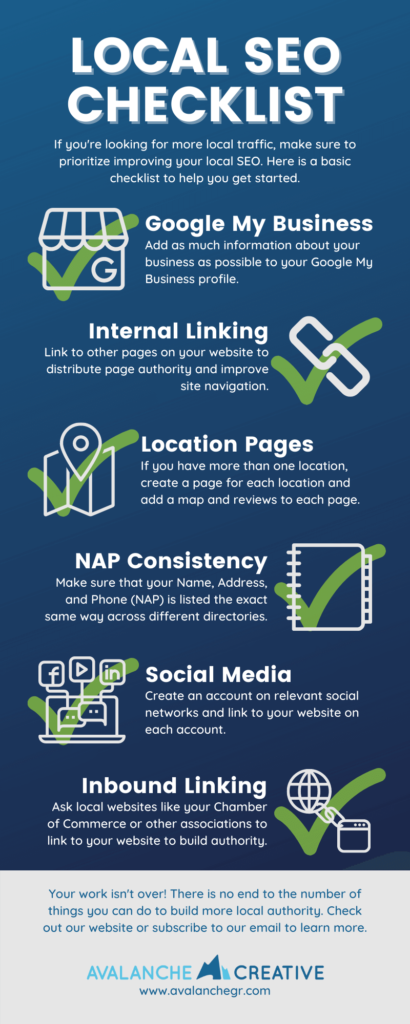Local SEO Checklist [INFOGRAPHIC]
There are hundreds, if not thousands, of little things you can do to improve your local SEO. It can be daunting. We've put together a more simple list that should not be viewed as a complete list, but, does contain some of the biggest, most important local SEO items to address for your business.

Category: Search Engine Optimization | Tags: guide, infographic, Local SEO
Setup & Optimize Google My Business
GMB is a free tool that lets you manage how your business appears on Google Search and Maps. That includes adding your business name, location, and hours; monitoring and replying to customer reviews; adding photos; learning where and how people are searching for you, and more.
Make sure to complete and verify all location(s) information and add relevant content.
Google My Business
Make sure you’ve gone through the following checklist items:
- Google My Business listing is completely filled out.
- Where possible, add your main service in the title of your GMB Listing.
- You have keyword-rich reviews that include the name of your service (both from your customers and from your responses to customer reviews).
- You have a complete GMB that includes the services you offer.
- You regularly post about your service (both promotional and educational) on Google My Business.
Bonus: Make sure to get on Bing Places. You can sync your Google My Business listing to Bing Local.
Double Bonus: How to Setup Google My Business Tracking
Improve Internal Linking
Internal linking supports website navigation, assists with information architecture and website hierarchy, and distributes page authority and ranking power among pages. Search engines like it for adding context to your content, which helps the user.
Add location and/or service area pages to your website
If you have more than one brick and mortar location or you service a regional area with multiple municipalities, create location pages. Create a page for each location. It’s very important not to duplicate content across these pages.
- Add a Google Map to each page
- Add a relevant YouTube video, if possible
- Add customer testimonials, ideally from your Google My Business Page
Make sure you have NAP consistency
NAP refers to your Name, Address, Phone Consistency. Directories and websites across the web list your NAP or business information (which often include a link to your site). Discrepancies like misspellings, inaccurate, duplicate, or missing information, abbreviations, lack of suite number or wrong phone number can be problematic. If Google can’t determine which information about your business is correct, it may not show your business at all in search results. Consistency is key.
Use Moz Local to check your listing score and manage information.
Get on social networks
Make sure you create any relevant social network accounts and add relevant information to the profiles, including a link to your site.
Get inbound links
Inbound links are incredibly powerful opportunities to boost your local SEO. Every inbound link tells Google you’re a legitimate company, and inbound links can also raise your domain authority.
To start acquiring inbound links, begin with your own network, which may include the Chamber of Commerce, business improvement districts, licensing bureaus, trade associations, resellers, vendors, partners and/or manufacturers and other affiliates. Ask them for a link to your site on a relevant page.
What’s next?
Unfortunately, your work isn’t over. Although the items above are crucial to getting more local exposure in the search engines, there is no end to what you can do. If you’ve accomplished everything above, we have some further resources to help you continue to dominate your local SEO. We’re also always available to chat if you have any questions.
There are many other activities you can do to promote your local search engine visibility, such as:
- Making sure you have updated and navigable terms and privacy policies.
- Write case studies that include relevant local information.
- Create a robust, industry-specific FAQ section of your website.
- Generate local PR and try to get in the news.
- Identify any mentions of your brand on the internet that don’t include a link to your site and ask for one.
Further Resources
Once you’ve gone through these items, it’s best to take a deep dive into your customer personas. Who are you trying to reach? What do they care about? What are they searching for? How can you help them better than your competition?
Start with your customer and keep the focus on your customer and you’ll start to see results from your local SEO.
Share this Image On Your Site
Share this article:
The Avalanche Email: Fun. Simple. Educational. No Selling.
Learn Result-focused SEO & Content
Join over 2,272+ others who get one email every Wednesday with simple instructions on how to get more website traffic and leads through SEO and content marketing. (Learn more about the email)
Share this article:






